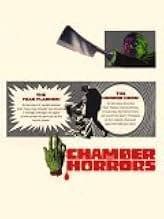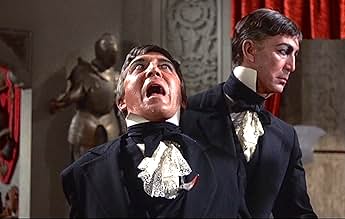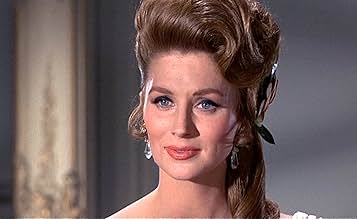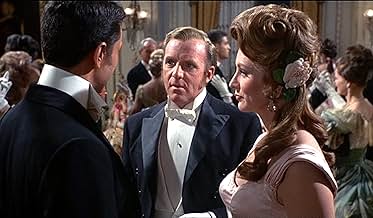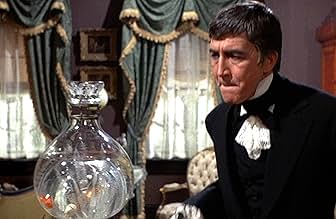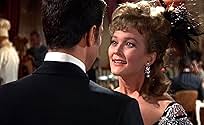NOTE IMDb
6,0/10
1,5 k
MA NOTE
Ajouter une intrigue dans votre langueA one-handed madman uses various detachable devices as murder weapons to gain revenge on those he believes have wronged him.A one-handed madman uses various detachable devices as murder weapons to gain revenge on those he believes have wronged him.A one-handed madman uses various detachable devices as murder weapons to gain revenge on those he believes have wronged him.
- Réalisation
- Scénario
- Casting principal
José René Ruiz
- Senor Pepe De Reyes
- (as Tun Tun)
Leon Alton
- Tour Group Member
- (non crédité)
Avis à la une
This is above all a fun horror film about two criminologists in the late 19th century Baltimore area(one decidedly English - Wilfred Hyde-White and the other decidedly Italian - Cesare Danova)working in a wax museum and uncovering crimes for/with the police. Apparently it was to be a pilot for a television series, and it is very unfortunate it never progressed that far. Hyde-White is always a treat and Danova is rather good too. This story deals with capturing Jason Cravatte - a local aristocrat with a fetish for girls in wedding gowns - dead or alive. Patrick O'Neal gives one of his best screen performances in the role of this psychotic, deranged killer who loses his hand and replaces it with all kinds of cutlery(ax, sword, scalpel, etc...) The film also boast the two gimmicks of the Fear Flasher when the screen will flash with green to let the viewer know something terrifying is about to happen and is preceded by the Horror Horn announcing its arrival. We are told in the beginning of the film that this will occur four times and none of those times are scary in the least bit. What makes this film work is the acting by Hyde-White, Danova, O'Neal, and people like Wayne Rogers as a constable, Jose Rene Ruiz as Pepe the dwarfish assistant, a cameo by Tony Curtis helps out, and all the acting is workmanlike and credible. Hy Averback , a television director of repute and ability, gives the film a very stylish feel with its Victorian-like atmosphere, swirling fogs, and seedy locales when needed. The wax museum itself is indeed impressive as well as is the denouement of the film. This "little" film - judging by its limited audience - is much better than one might at first expect given the gimmicks and story.
"Chamber of Horrors" is deliciously absurd and tacky horror of the 1960s, and I love it wholeheartedly! The plot of the film was intended as the pilot for a TV-series, but eventually it was considered too gruesome and shocking for television. So, instead, director Hy Averback and his crew turned the concept into a long-feature film and added a few redundant but contemporary popular gimmicks like the "Fear Flasher" and the "Horror Horn". These features are obviously inspired by the marketing tricks invented by the legendary William Castle ("The Tingler", "13 Ghost", ...) and warn viewers when supposedly shocking sequences are about to start, so they have the time to cover eyes and ears. Cute but derivative, of course, and quite unnecessary because "Chamber of Horrors" is already sufficiently inventive, entertaining and compelling without having to use silly gimmicks.
I'd really wish that someone in Hollywood would pick up the idea and produce the overdue TV-series after all! The concept is inspired by the 1953 classic "House of Wax" and set in Baltimore around the end of the 19th century. The local wax museum proudly exhibits gruesome real-life crimes and the series would feature the museum's two curators as amateur-criminologists that outsmart the police and solve macabre murder cases. Clever! The first assignment for the handsome Anthony Draco (Cesare Danova) and the witty Harold Blount (Wilfred Hyde-White) is apprehending the crazy Jason Cravatte, who strangled his fiancé with her own hair and married the corpse afterwards. Cravatte is arrested and sentenced to death, but he escapes during prison transport by chopping off his own manacled hand and throwing himself into the Baltimore River. With a hook for a hand and a sexy French prostitute as an accomplice, Cravatte returns to Baltimore with the fiendish plan to kill everyone who wronged him in court.
Vintage Grand-Guignol material, in other words, and "Chamber of Horrors" is fantastically entertaining thanks to its bizarrely twisted plot details, grotesque scenery and vivid acting performances. Patrick O'Neal is so delightfully sinister and menacing as the homicidal Jason Cravatte that even his famous lookalike Vincent Price couldn't had played the role better! The script also introduces numerous intriguing supportive characters that were clearly supposed to become recurring regulars in the series, so it's a crying shame the format didn't go through. Even in the extended 99-minutes version, the gore and bloodshed are rather limited, so feel free to keep watching when you see the Fear Flasher and hear the Horror Horn.
I'd really wish that someone in Hollywood would pick up the idea and produce the overdue TV-series after all! The concept is inspired by the 1953 classic "House of Wax" and set in Baltimore around the end of the 19th century. The local wax museum proudly exhibits gruesome real-life crimes and the series would feature the museum's two curators as amateur-criminologists that outsmart the police and solve macabre murder cases. Clever! The first assignment for the handsome Anthony Draco (Cesare Danova) and the witty Harold Blount (Wilfred Hyde-White) is apprehending the crazy Jason Cravatte, who strangled his fiancé with her own hair and married the corpse afterwards. Cravatte is arrested and sentenced to death, but he escapes during prison transport by chopping off his own manacled hand and throwing himself into the Baltimore River. With a hook for a hand and a sexy French prostitute as an accomplice, Cravatte returns to Baltimore with the fiendish plan to kill everyone who wronged him in court.
Vintage Grand-Guignol material, in other words, and "Chamber of Horrors" is fantastically entertaining thanks to its bizarrely twisted plot details, grotesque scenery and vivid acting performances. Patrick O'Neal is so delightfully sinister and menacing as the homicidal Jason Cravatte that even his famous lookalike Vincent Price couldn't had played the role better! The script also introduces numerous intriguing supportive characters that were clearly supposed to become recurring regulars in the series, so it's a crying shame the format didn't go through. Even in the extended 99-minutes version, the gore and bloodshed are rather limited, so feel free to keep watching when you see the Fear Flasher and hear the Horror Horn.
Jason Cravatte (Patrick O'Neal) forces a reverend at gunpoint to marry him and the dead body of Melinda Sawyer. The police is brought in but Jason had already escaped. Anthony Draco (Cesare Danova) and Harold Blount (Wilfrid Hyde-White) own a wax museum and consider themselves amateur detectives. The police searches throughout Baltimore for the disturbed killer.He is caught and sentenced to hang. He manages to escape from a train transport but he had to chop off his own hand. With his new hand replacement, he takes revenge upon those who wronged him.
This is an old horror with a gimmick. At the beginning, the narrator explains the Fear Flasher and Horror Horn would precede the most horrific scenes. That is the best part of the movie. It's campy and fun in treating it seriously. The actual use of the gimmick does not do much. The grotesque violent scenes are not so shocking especially with modern horror eyes. There is blood but the camera cuts away before the actual violence. The story starts interesting but it flounders in the second half. The characters don't have the special interest and the actors are not the most charismatic. It's a passable bland old horror with a cheesy gimmick which is more fun in the imagination than it is in reality.
This is an old horror with a gimmick. At the beginning, the narrator explains the Fear Flasher and Horror Horn would precede the most horrific scenes. That is the best part of the movie. It's campy and fun in treating it seriously. The actual use of the gimmick does not do much. The grotesque violent scenes are not so shocking especially with modern horror eyes. There is blood but the camera cuts away before the actual violence. The story starts interesting but it flounders in the second half. The characters don't have the special interest and the actors are not the most charismatic. It's a passable bland old horror with a cheesy gimmick which is more fun in the imagination than it is in reality.
Borrowing a page from the playbook of producers like William Castle, Al Adamson, Nicholson and Arkoff at AIP and the like, this was a lot of fun for me as a kid with the hokey gimmicks of the "Fear Flasher" and the "Horror Horn" added to prevent the more squeamish members of the audience from dying of sheer fright, (the goosebump-inducing voice of the Narrator in the "Instructional" sequence was none other than CANNON himself, William Conrad, who actually directed one of these horror potboilers for Warner's, the Dean Jones/Connie Stevens starrer TWO ON A GUILLOTINE.)
This rehash of the definitely superior HOUSE OF WAX with Vincent Price, gives us the grisly tale of serial strangler Jason Cravette (Patrick O'Neal in a bravura performance), who is finally caught literally red-handed as he ritualistically weds and beds his latest victim, ex mortis.
His subsequent escape and its gory consequences, (he goes from being caught red-handed to losing one of them), becomes the fodder for a sensational museum of mass murderers run by suave local entrepreneur Anthony Draco (Cesare Danova, one of Warner's second-tier matinee idols.) Once worried about operating in the red, soon Draco and his associates, the marvelous Wilfrid Hyde-White and diminuitive sidekick Tun-Tun (the 'Mini-Me' of his day) are back in business, as the slippery Cravette gives our heroes and the local authorities more red than they know what to do with, cutting a vengeful swath through the ranks of all those responsible for his near-incarceration.
Hy Averback keeps all the right balls in the air with a speedy and sure sense of direction, and there's much delightful interplay between the lead characters, especially Danova and Hyde-White. Look closely and not only will you see Tony Curtis in an uncredited cameo, but a baby-faced Wayne Rogers as well, as a very unlucky constable (whom Averback would direct years later in episodes of TV's M*A*S*H...talk about six-degree associations!)
With the lush photography provided by master d.p. Richard Kline, and a score by William Lava that reminds us that he wasn't just at Warner's to provide soundtracks for Bugs Bunny and the Road Runner, this was about as classy as genre-B pics could get for the mid-'60's, not discounting the efforts of A.I.P. with the Price/Poe films. Not available in any medium that I'm aware of, you'll have to keep your eyes peeled on AMC or TNT late night to catch this worthy rarity.
This rehash of the definitely superior HOUSE OF WAX with Vincent Price, gives us the grisly tale of serial strangler Jason Cravette (Patrick O'Neal in a bravura performance), who is finally caught literally red-handed as he ritualistically weds and beds his latest victim, ex mortis.
His subsequent escape and its gory consequences, (he goes from being caught red-handed to losing one of them), becomes the fodder for a sensational museum of mass murderers run by suave local entrepreneur Anthony Draco (Cesare Danova, one of Warner's second-tier matinee idols.) Once worried about operating in the red, soon Draco and his associates, the marvelous Wilfrid Hyde-White and diminuitive sidekick Tun-Tun (the 'Mini-Me' of his day) are back in business, as the slippery Cravette gives our heroes and the local authorities more red than they know what to do with, cutting a vengeful swath through the ranks of all those responsible for his near-incarceration.
Hy Averback keeps all the right balls in the air with a speedy and sure sense of direction, and there's much delightful interplay between the lead characters, especially Danova and Hyde-White. Look closely and not only will you see Tony Curtis in an uncredited cameo, but a baby-faced Wayne Rogers as well, as a very unlucky constable (whom Averback would direct years later in episodes of TV's M*A*S*H...talk about six-degree associations!)
With the lush photography provided by master d.p. Richard Kline, and a score by William Lava that reminds us that he wasn't just at Warner's to provide soundtracks for Bugs Bunny and the Road Runner, this was about as classy as genre-B pics could get for the mid-'60's, not discounting the efforts of A.I.P. with the Price/Poe films. Not available in any medium that I'm aware of, you'll have to keep your eyes peeled on AMC or TNT late night to catch this worthy rarity.
"Chamber of Horrors" sure reminds me of some of William Castle's films, as it begins with a prologue narrated by William Conrad. It explains how scary the film is but as a special service to the squeamish in the audience, a red light will flash and weird music will go off when one of four horrifying moments are about to begin! This is cheesy but also fills the movie with kitschy fun.
The film begins with a truly horrifying and wonderful scene in which a total psycho (Patrick O'Neal) forces a minister to marry him....to a dead woman!! The guy is 100% nuts but clever--and manages to elude the police for some times after this. Eventually, when he is captured, he manages to escape both times--and I won't go in to detail about it, but the second time is a doozy and everyone assumes he's dead! And, from here on, the film bears a lot of similarity to the wonderful film "House of Wax" (the Vincent Price version, not the new crappy one) as well as the Dr. Phibes films--some amazingly gory murders, all in the name of revenge. This portion of the film is pretty good, albeit a bit slow at times.
What intrigued me about this film was seeing Patrick O'Neal in a role totally unlike his other film and TV appearances. He was good, mind you--but NOT the typical sort of O'Neal! Also I appreciated that although the subject matter was grisly, it was not at all explicit--and the red flashing lights really weren't necessary. I am thrilled, as I think many horror films just go too far.
Overall, I liked this film very much--O'Neal's character was great and the story quite exciting. The only serious problems were the occasional bad writing, as intended victims just acted too dumb at times--such as the cop (Wayne Rogers) who chose to look for a serial killer out to kill him TOTALLY ALONE! When this character found O'Neal, instead of shooting him on sight, he allowed him to get close to him...too close. Another case of bad writing involved the assistant, Pepe, who hears a noise and TELLS NO ONE--going to investigate it himself!! Too dumb--and sad because otherwise it was a thrilling little movie.
By the way, the way the film ended it seemed apparent this was meant as either a TV pilot or the first in a series. Sadly, this was not to be.
The film begins with a truly horrifying and wonderful scene in which a total psycho (Patrick O'Neal) forces a minister to marry him....to a dead woman!! The guy is 100% nuts but clever--and manages to elude the police for some times after this. Eventually, when he is captured, he manages to escape both times--and I won't go in to detail about it, but the second time is a doozy and everyone assumes he's dead! And, from here on, the film bears a lot of similarity to the wonderful film "House of Wax" (the Vincent Price version, not the new crappy one) as well as the Dr. Phibes films--some amazingly gory murders, all in the name of revenge. This portion of the film is pretty good, albeit a bit slow at times.
What intrigued me about this film was seeing Patrick O'Neal in a role totally unlike his other film and TV appearances. He was good, mind you--but NOT the typical sort of O'Neal! Also I appreciated that although the subject matter was grisly, it was not at all explicit--and the red flashing lights really weren't necessary. I am thrilled, as I think many horror films just go too far.
Overall, I liked this film very much--O'Neal's character was great and the story quite exciting. The only serious problems were the occasional bad writing, as intended victims just acted too dumb at times--such as the cop (Wayne Rogers) who chose to look for a serial killer out to kill him TOTALLY ALONE! When this character found O'Neal, instead of shooting him on sight, he allowed him to get close to him...too close. Another case of bad writing involved the assistant, Pepe, who hears a noise and TELLS NO ONE--going to investigate it himself!! Too dumb--and sad because otherwise it was a thrilling little movie.
By the way, the way the film ended it seemed apparent this was meant as either a TV pilot or the first in a series. Sadly, this was not to be.
Le saviez-vous
- AnecdotesAccording to an article in the 9/28/66 edition of "Variety", this film was the second-most profitable film in release at the time.
- GaffesAt the police department, on the door to room 112 it states it is the Exhibits Room, but in the hall outside, room 112 is indicated as the District Attorney's office.
- Citations
Anthony Draco: Can you describe him?
Marie Champlain: He's... he's tall and uh... he's dark and um... uh... soft-spoken. He moves very quietly. What's wrong me? He's the easiest man in the world to identify. His right hand is missing.
- Crédits fousBefore the studio emblem or opening credits, the following message is narrated as well as seen on screen: "Ladies and gentlemen, the motion picture you are about to see contains seen so terrifying the public must be given grave warning. Therefore, the management has instituted visual and audible warning at the beginning of each of the Four Supreme Fright Points."
" The Fear Flasher is the visual warning."
" The Horror Horn is the audible warning."
" Turn away when you see the FEAR FLASHER!"
"Close your eyes when you hear the HORROR HORN!"
- Versions alternativesProduced as a TV series pilot, this film was determined to be too violent for the small screen and given theatrical distribution instead. Added for this release was an exploitation device called the "Fear Flasher/Horror Horn", ostensibly to warn the audience of the "Four Supreme Fright Points" (although it was not applied to the picture's most explicitly violent moment, the climactic fate of the villain). This device was explained in an introductory sequence narrated by William Conrad. Upon first showing on US network television, both the device and its explanation were deleted, but in subsequent syndication to local stations in the 1970s and '80s, some such prints were seen.
- ConnexionsFeatured in Deadly Earnest's Spooky Colour Marathon (1975)
- Bandes originalesAn der schönen, blauen Donau, Op. 314 (On the Beautiful Blue Danube)
(uncredited)
Music by Johann Strauss
Played at the party
Meilleurs choix
Connectez-vous pour évaluer et suivre la liste de favoris afin de recevoir des recommandations personnalisées
- How long is Chamber of Horrors?Alimenté par Alexa
Détails
- Date de sortie
- Pays d’origine
- Langue
- Aussi connu sous le nom de
- Chamber of Horrors
- Lieux de tournage
- Société de production
- Voir plus de crédits d'entreprise sur IMDbPro
- Durée1 heure 20 minutes
- Mixage
- Rapport de forme
- 1.85 : 1
Contribuer à cette page
Suggérer une modification ou ajouter du contenu manquant

Lacune principale
By what name was La chambre des horreurs (1966) officially released in India in English?
Répondre


